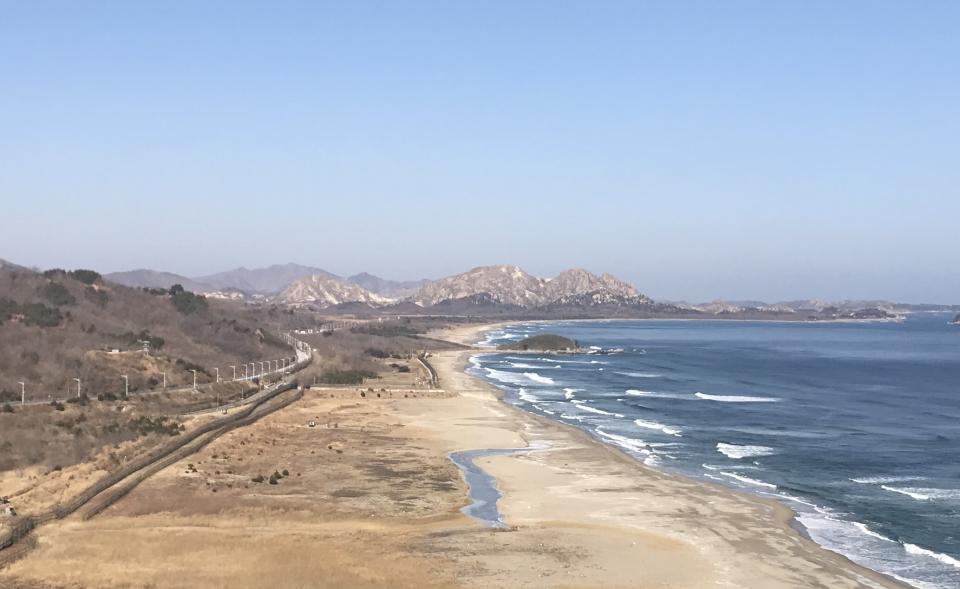At DMZ, scars remain even as South Korea tries to heal
TEN MILES SOUTH OF THE DMZ, South Korea—It doesn’t matter how clean a life you’re living, how spotless your police record, how pristine your soul. When a heavily armed soldier steps onto your bus, looks down at the papers in his hand, and then begins apprising you with cold eyes, you start finding religion real quick.
We’re 10 miles south of the Korean Demilitarized Zone, or DMZ. The border between the democratic South Korea and the totalitarian North Korea, it’s the most heavily armed and fiercely guarded stretch of land on earth, a four-kilometer-wide, 155-mile-long stretch of blood-drenched soil and rock, a six-decade-old scar that can’t heal. It’s both barbed wire and metaphor, a brutally real reminder of war and a constant, waking nightmare.
And somehow, it’s also a tourist attraction.
Finding the DMZ isn’t hard; you start anywhere in South Korea and head north until you hit roughly the 38th parallel, the latitude that once marked the boundary between North and South Korea. But finding a spot on the DMZ where you won’t get detained or worse — well, all you need to do for that is consult one of the dozens of tourist operations offering history for a price. There are multiple observatories along the DMZ where tourists can look out across the DMZ and see North Korea itself, close enough to almost touch but utterly unreachable.
The most notable of these spots is the Joint Security Area, also known as Panmunjom, in the western part of the Korean peninsula. There, tourists can visit the Peace Museum, the building where North and South Korea signed the ceasefire agreement in 1953 that halted the Korean War. The border between North and South Korea runs literally right through the center of that building, and you can go stand on the far side of the room and be in North Korea. Walk out the door that leads from that side of the room to the country beyond, though, and that literally might be the last anyone ever hears from you.

We’re not there. We’re much closer to PyeongChang, the site of this year’s Winter Olympics, at a far more accessible and tourist-friendly locale. Less than 70 miles from the stadium that will host the Opening and Closing Ceremonies stands the Goseong Reunification Observatory, a squat, squarish block that looks out on North Korea, just a few hundred feet away. (A sleek, modernist glass-walled replacement is rising next door.)
The DMZ’s proximity to PyeongChang is a sharp reminder of just how divided the two Koreas remain, even for all the recent talk of thawing between the two nations. North Korea is sending athletes to compete in, and dancers to perform at, the Winter Olympics, but no gesture is without hidden meaning between these two nations. Even as North Korea extends a hand in friendship, it’s also flexing in aggression.
At about the same time that we were looking into North Korea, more than 10,000 soldiers were marching in Kim Il Sung Square in Pyongyang, 150 or so miles away. Details remain scarce about the parade, but it was clearly an attempt to show a bit of attitude on the eve of the Olympic Games. It was a reminder that while tensions may cool between the two nations, the embers never completely go out.
It’s worth noting that these military parades don’t always have the desired effect. “We don’t much care about the parades,” says Juhong Won, a former sniper in the South Korean Army who now works for the Olympics’ press office. “We see it almost every day. We don’t worry about it.”
The Goseung Reunification Observatory — “reunification” being both a common name and a common aspiration in South Korea — is a curious mix of the fascinating and the mundane. You can look out at the barbed wire and fencing that lines the beach in double rows — North Korea has a history of sending spies into South Korea via water — and at the same time, you can buy plenty of inexpensive South Korean snacks, drinks, and souvenirs. (The ticket office a few miles back down the road actually sold DMZ-branded liquor and binoculars with camo paint.)

There are as many ways to process the horrors of the DMZ, and the existential threat to South Korea that it still represents, as there are South Koreans. And while traditional monuments, some religious, some military, stand on the grounds of the observatory, there’s currently also an arts festival that ranges from the passionate — a drum circle that thunders loud enough to be heard in North Korea — to the peculiar, like the woman who dressed as a feathered unicorn and slowly fluttered in the breeze coming in off the sea.
You look out over the DMZ, and you expect to see guardhouses, rails of barbed wire atop high walls, spotlights. There’s none of that here. You can’t even see the boundary itself; there’s just the curve of the shore and, beyond it, the peaks of the Kumgang Mountains in North Korea.
With no human interference, the DMZ itself has, ironically, become a remarkable nature preserve. Once pockmarked by mines and razor wire, the four-kilometer-wide space is now home to musk deer, squirrels, shrikes, and butterflies. Still, there’s something unsettling about the fact that the boundary still remains, now hidden by natural beauty.
A few miles back into South Korea stands the DMZ Museum, and it’s here that the nation is coming to grips with the war and its effects. A linear history proceeds from the earliest skirmishes between the nations right on up to incidents in the last few years. You can walk on clear glass with deactivated mines beneath, and you can look at the propaganda that both nations dropped on one another. The propaganda ranges from dense political tracts to borderline pornography, from loving portraits of dear leaders to heroic depictions of soldiers in battle.
There’s also a gift shop, of course, where one can buy DMZ-branded bookmarks, phone covers, and chargers. While the desire to commemorate the museum is admirable, there are a few curious choices; an ornament with the inscription “I [heart] DMZ” appears to have lost something in translation.
As we’re leaving the museum, speakers are blaring the dramatic coda to Air Supply’s “Making Love Out Of Nothing At All.” It’s prime cheese, a lite-rock earworm. And I honestly can’t tell whether it’s an intentional selection to entertain visitors, or an example of Western propaganda. Either one fits just fine.
The saddest aspect of the DMZ as it is today is just how many generations of South Koreans accept it as a fact of life. Indeed, our tour guide tells us that reunification, so long a goal of so many separated South Koreans, doesn’t hold as much interest for the younger generations of South Koreans. They know they’d be forced to shoulder burdens of helping North Koreans join the 21st century, and many aren’t entirely keen on paying for the aggressions of their great-grandparents.
Many, but not all. “Most of us still hope for reunification,” Juhong says. “It would be best for both North Korea and South Korea.”
Until then, though, there stands the DMZ, a silent reminder that what divides us, sadly, is often stronger than what unites us.

____
Jay Busbee is a writer for Yahoo Sports. Contact him at jay.busbee@yahoo.com or find him on Twitter or on Facebook.
